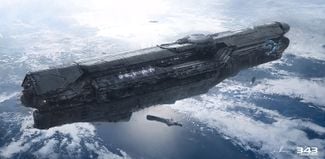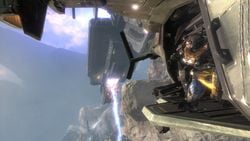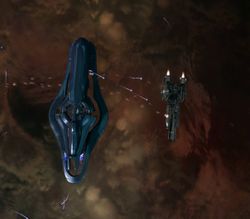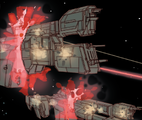Titanium-A armor
From Halopedia, the Halo wiki

Titanium-A armor is the most common form of battle plating used by starships constructed by humanity. It is employed on both civilian and military vessels as a general-use hull material designed to protect the spacecraft in question from damage ranging from micrometeorite impacts to hypervelocity projectile rounds and directed-energy weapons.[1]
Overview[edit]
Characteristics[edit]
Titanium-A consists of high-grade Titanium-50,[2] specially-strengthened and reinforced at the molecular level[3] with stacked nanotubes, elastic polymer composites and intermetallic laminates - resulting in a plating material capable of withstanding hypervelocity projectile impacts and energy weapon attacks.[1][4] The plates themselves are typically a dull grey in colouration, and are embedded with thermal superconducting radiators that work to radiate thermal energy from the ship into space.[5] The space between individual armor plates is filled with shock-hardening fluids and encapsulated healing agents to reduce spall from impacts and automatically seal small hull breaches.[4]
Titanium-A3 armor[edit]
Later during the Human-Covenant War, more advanced forms of Titanium-A were introduced, fitted with thermal superconducting elements to help strengthen against energy weapon impacts.[1] One such example is Titanium-A3, a variant of Titanium-A battle plate developed by the Office of Naval Intelligence's Materials Group. Like Titanium-A, it is chemically altered on the molecular level to produce a stronger plate for ship hulls. It has only been noted to be used on the UNSC Infinity, whose hull is composed of 4.9-meter-thick Titanium-A3 battleplate.[6]
Following the Human-Covenant War, some UNSC military vessels received energy shielding to allow the ships to absorb more damage.[7]
Defensive capabilities[edit]
Prior to the Human-Covenant War, a single Magnetic Accelerator Cannon slug was capable of penetrating any vessel's Titanium-A armor plating.[8] The armor took a newfound importance after the beginning of the Human-Covenant War: to contend with the Covenant's plasma weaponry, humans needed armor that would withstand the heat of the directed plasma. Despite its strength and resistance to heat, however, the Titanium-A plating is usually boiled away within seconds on contact with Covenant plasma torpedoes, and does not effectively dissipate the plasma. Energy projectors are able to pierce meters with relative ease.[3][9][10][11] Pulse laser turrets can reduce the hull of a heavy frigate to about four centimeters in a single hit.[12] Even energy swords can do significant damage to Titanium-A armor.[13]
Titanium-A armor plating can be layered with tungsten for a radiation absorption rating of 5 and presumably grant greater protection against plasma weaponry.[14] Unlike the Covenant's nanolaminate hull plating, Titanium-A plating is not effective during direct collisions with other vessels. After a direct collision with Proclamation's Tithe, the UNSC Spirit of Fire was heavily damaged, while the Sinaris-pattern heavy destroyer was seemingly unharmed.[15] When the destroyer UNSC Iroquois collided with a Covenant stealth ship, the Iroquois lost all two meters of Titanium-A plating, although it did succeed to disabling the Covenant vessel.[16]
Usage[edit]
Titanium-A, alongside other technologies such as Magnetic Accelerator Cannons, was developed in the 25th century as a response to the Insurrection.[17] Since its introduction, it has served as the main hull material used on the warships of the CMA Navy and UNSC Navy. As much as a third of a given ship's mass may be composed of Titanium-A, with plate thicknesses often measuring dozens of centimetres thick.[3] Frigates such as the Paris-class heavy frigate may have up to 60 centimetres (24 in) of Titanium-A plating,[18][19] with destroyers like the Halberd-class having plates as thick as 2 metres (6.6 ft).[20][19] Marathon-class heavy cruisers, the standard line warship of the UNSC Navy, have plates with 191 centimetres (75 in) of Titanium-A,[21] while some carriers have armour plating thickness of 36 centimetres (14 in).[19] Other carriers, such as UNSC Stalingrad, have multiple metres of Titanium-A plate.[22] Outside of warships, Titanium-A armour is used as the hull material for support craft such as the D77 Pelican[23] and GA-TL1 Longsword,[24] alongside slipstream space probes[25] and even drop pods such as Long range stealth orbital drop pods.[26] Refit stations[27] and construction platforms, such as Station Delphi, are essentially slabs of Titanium-A armor plating.[28]
The UNSC uses Titanium-A for construction of military bases as well, to make them less susceptible to destruction. Underground facilities such as HIGHCOM Facility Bravo-6, CASTLE Base[29] and Camp Hathcock used Titanium-A armor in their superstructures.[30] Even lockers used by UNSC personnel are reinforced with a centimeter of Titanium-A armor plating.[24] Eridanus Secundus, a United Rebel Front asteroid base located in the Eridanus system, was reinforced with a layer of Titanium-A armor which also helps deflect UNSC and Covenant sensors.[31] On an infantry level, Titanium-A serves as the primary material layer for the armoured shell of the MJOLNIR Powered Assault Armor system,[32] and is even used in infantry equipment such as the grappleshot.[33]
In the civilian world, noncombat starships such as freighters may also be covered in a layer of Titanium-A, albeit much thinner and their military counterparts. These armour layers serve to protect the ship from regular space debris such as micrometeorites, as opposed to hostile projectiles.[1]
Gallery[edit]
The UNSC Spirit of Fire is heavily damaged by a collision with a Covenant destroyer.
The UNSC Pillar of Autumn's modified hull is damaged by plasma turrets.
The UNSC Infinity's unshielded hull is pierced by a glassing station.
A Longsword's hull is made up of Titanium-A armor.
A Marathon-class heavy cruiser's hull being pierced by a CAS-class assault carrier's energy projector.
Sources[edit]
- ^ Jump up to: a b c d Halo Encyclopedia (2022 edition), page 114
- ^ Halo: Ghosts of Onyx, chapter 22
- ^ Jump up to: a b c Halo Encyclopedia (2011 edition), page 315
- ^ Jump up to: a b Halo: Warfleet, page 19
- ^ Halo Mythos, page 83
- ^ Halo 4, Infinity Briefing Packet
- ^ Halo 4 - Spartan Ops, episode Departure
- ^ Halo: Contact Harvest, chapter 7
- ^ Halo: Escalation, issue 5
- ^ Halo: Escalation, issue 6
- ^ Halo: Reach, campaign level Tip of the Spear
- ^ Halo: The Fall of Reach, chapter 11
- ^ Halo: First Strike, chapter 8
- ^ Halo: Evolutions - The Impossible Life and Possible Death of Preston J. Cole, section 7
- ^ Halo Wars, campaign level Repairs
- ^ Halo: The Fall of Reach, chapter 18
- ^ Halo: Evolutions - The Impossible Life and Possible Death of Preston J. Cole, section 4
- ^ Halo: First Strike, chapter 22
- ^ Jump up to: a b c Halo Encyclopedia (2011 edition), page 258-261
- ^ Halo: The Fall of Reach, Prologue
- ^ Halo: The Essential Visual Guide, page 42
- ^ Halo: Ghosts of Onyx, chapter 32
- ^ Halo: First Strike, chapter 1
- ^ Jump up to: a b Halo: First Strike, chapter 5
- ^ Halo: First Strike, chapter 32
- ^ Halo: Ghosts of Onyx, Prologue
- ^ Halo: The Fall of Reach, chapter 33
- ^ Halo: Ghosts of Onyx, page 51
- ^ Halo: First Strike, chapter 11
- ^ Halo: The Fall of Reach, chapter 24
- ^ Halo: First Strike, chapter 28
- ^ Halo Encyclopedia (2022 edition), page 81
- ^ Halo Encyclopedia (2022 edition), page 85








